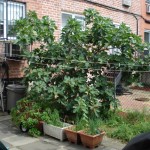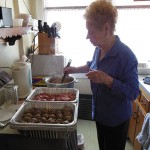by Paula D.
on April 16, 2025 8:56 am in Gardening
The time is now. The ground is thawing and the first bulbs of spring are breaking through the surface soil. What do you want your garden to look like this year? What do you want it to yield? Think about edible landscaping, where food plants double as beautiful design features. Consider garden themes: like planting a tea garden, herb gardens, or a culture garden inspired by your heritage or in honor of someone else’s. Think outside the garden box. Make sketches of your veg layout and keep a garden journal to house what is working, what is not, critters, taste, time, rain. Sketch drawings as your garden blossoms. Consider pushing the boundaries of gardening as a personal expression to foster a deep connection with nature.
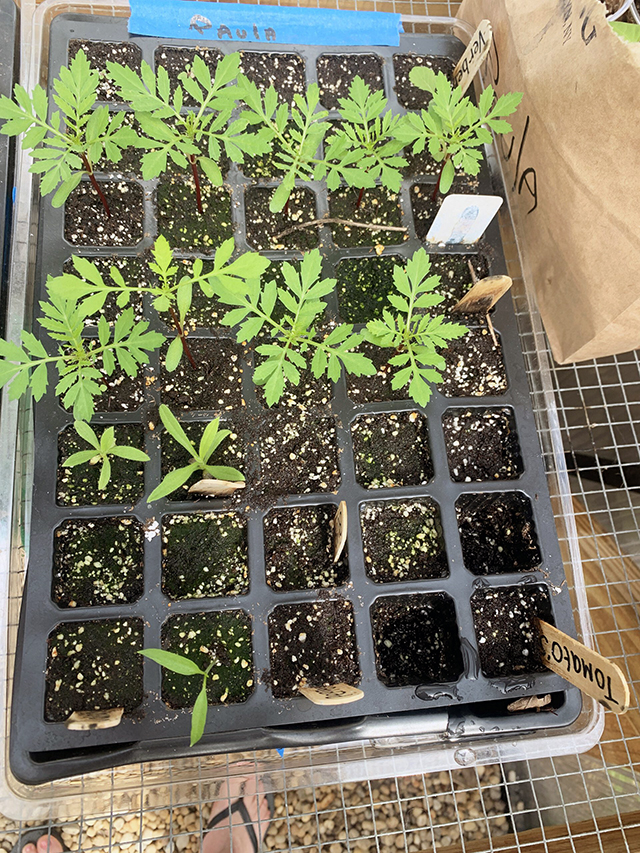
This is a classic case of overwatering—see the green algae. But it’s not a deal breaker. And remember, you learn by doing.
Seeds can be tricky and that’s where we are in the season, followed by tilling the soil when temperatures are consistently reaching 50 degrees. This ensures overwintering insects like bees, are ready to emerge.
Let’s discuss procedure for seeds:
Start With Quality Seeds: Check the expiration date on the packet! Often we overlook the simplest things.
Soil: Use a well-draining potting mix instead of garden soil for indoor or greenhouse seed-starting. This medium helps prevents waterlogging and reduces fungal disease risks. Use recycled containers.
Light: Veggie and herb seedlings need a lot of light—about 12-16 hours a day. A sunny window or a grow light is essential.
Temperature: Most seeds germinate best in warm, consistent temperatures – 65-75°F. They will not germinate if it is too cold or drafty.
Water: Keep the soil consistently moist—avoid letting it dry out, but steer clear of sogginess! Overwatering can drown the little ones before they sprout.
Thin Out: Once seedlings develop a couple of leaves, thin them out to avoid overcrowding. This means separating the baby plants into individual containers if needed, and discard weak sprouts or yellowed ones.
Harden Off: This is important and takes some dedication. Gradually introduce indoor-grown seedlings to outdoor conditions. Meaning, you need to move them outside in a sunny, protected area for a few hours during the day and take them back inside in the evening.
Label, Track, Plant: By Mid- May, it’s time to transfer the plants into the ground outside with compost. Keep a log of when and where you planted in your journal.
Starting your garden from seed is a wonderful way to learn more about gardening and spark curiosity in young minds, but we are busy humans! And it’s totally fine to buy starters too. I recommend visiting Lisena Garden Center (125 Crossbay Blvd, Broad Channel, NY), where Fernando and the team offer the organic essentials and Edgemere Farm – follow them on Instagram for their spring plant sale info. Both are excellent local resources for all your garden wants.
For more gardening tips, follow me on Instagram (@theglorifiedtomato) and at the @beach91streetcommunitygarden all season long!
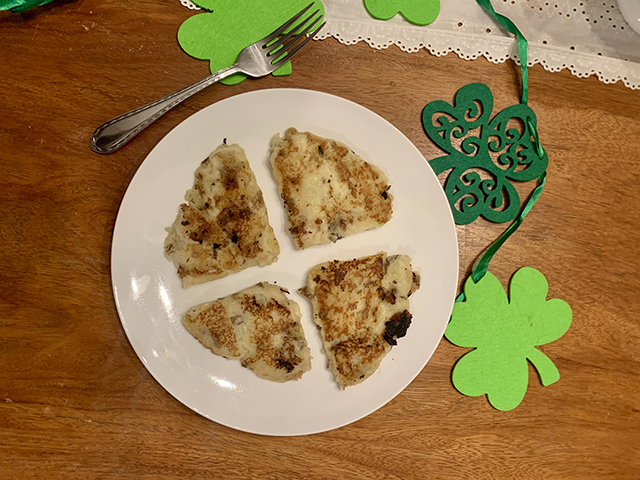
Potatoes trace their roots to the high Andes of South America. Spanish conquistadors discovered this tuber in the 16th century and brought it back to Europe, where it eventually found a special place in Ireland. The cool climate and rich soil of the Emerald Isle proved the perfect place for the potato.
Quickly the potato became more than just a food crop—it became a symbol of resilience. Despite its somber chapters, like the Great Famine, the potato’s journey is one of survival and adaptability. As we celebrate St. Patrick’s Day this month, we honor not only Ireland’s vibrant traditions but also the unassuming hero that nourished the nation. The potato is a cultural icon and a dependable staple food in Irish culture.
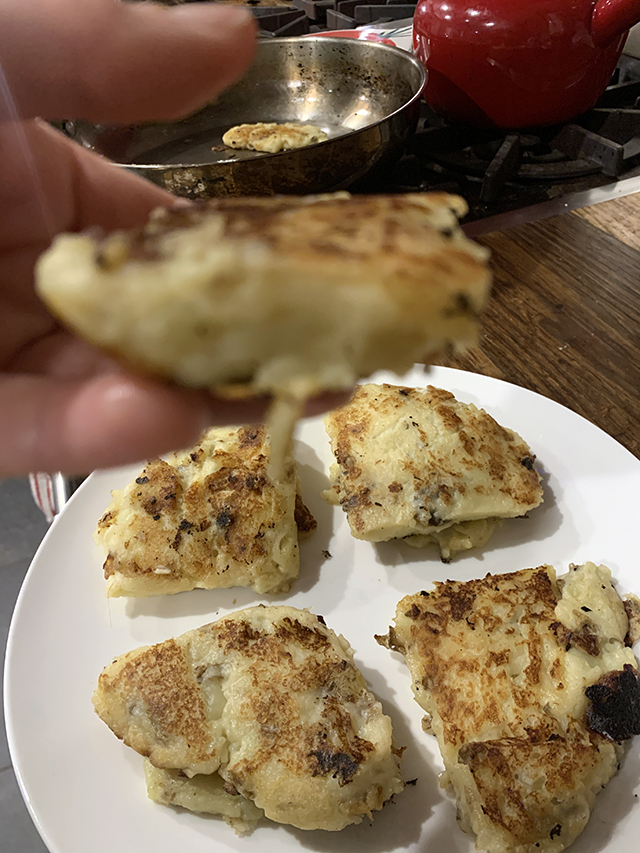
In celebration of St. Paddy’s Day and our cherished Irish community here on our riviera, I’ve decided to fry into the world of Farls!
Irish Potato Farls
Makes 8 small farls
Ingredients
1 pound floury potatoes
3.5 tablespoons butter
¼ plain flour, plus extra for rolling out
¼ tsp baking powder
Salt and black pepper
Extra butter for cooking
Directions:
- Peel the potatoes, then cut them into quarters. Cover with water in a pot, season with salt and cook for about 15 minutes until they become tender. Drain, then return the potatoes to the pan.
- In the same pan, melt the butter with the potatoes. Mash until smooth or use a potato ricer.
- Sift the flour with the baking powder into the potato mix and stir to combine. Taste for seasoning and adjust if needed. You can add more flour if the mixture is too wet and a little milk if it is too dry.
- Divide the dough into two halves. Form one piece into a ball, then roll it out on a floured surface and into a rough 5 inch circle, a half inch thick. Cut the circle into quarters.
- Heat a non-stick frying pan over medium heat with a little butter. Transfer the four pieces to the pan and cook for about 4 minutes or until golden brown. Flip over and cook the other side for another 4 minutes. Remove to a plate with paper towels to drain. Repeat the process with the other half of the dough mix.
Note: It took me some time to get the feel of frying the farls. Take your time. Make sure the first side is crisp before you flip so they don’t break apart.
Recipe by Jane Baxter
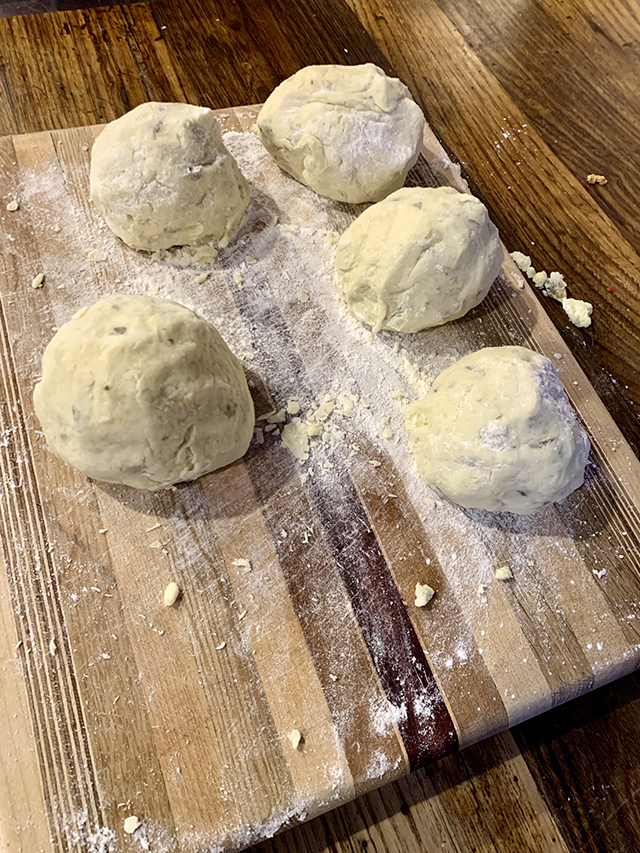
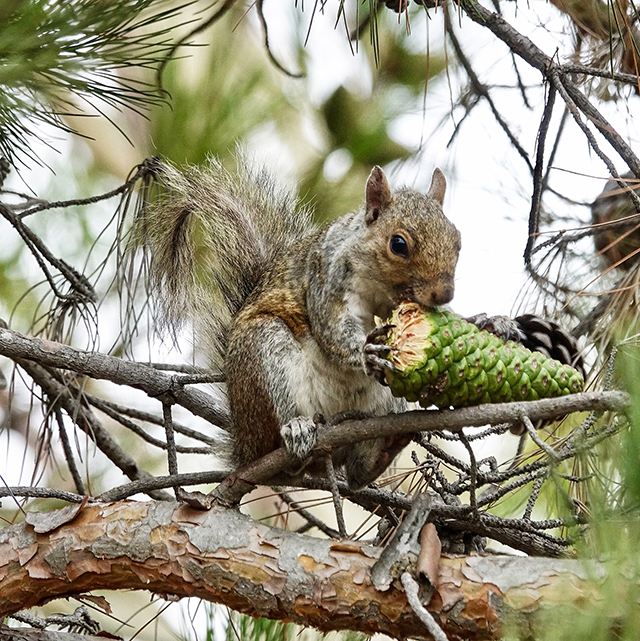
Squirrels are inadvertent urban foresters. By scattering seeds that grow into trees and plants, they help regenerate our parks and contribute to NYC’s ecosystem health. Source: Wikipedia
There’s a tree in Brooklyn I visit these days. There are so many trees on the mainland—I only remember that once I leave Rockaway. The tall oaks, London planes, and maples create a lovely canopy. There’s a whole world happening above our busy streets below.
On my last visit to the tree, I noticed a squirrel popping its head out of a perfectly sized hollow, two stories high! The busy creature was up and down the tree. On the ground, the squirrel was stuffing leaves into its mouth and transporting them up the tree. Back and forth, back and forth. I hadn’t seen anything like it before. “She must be building a nest!” I thought. And then, I remembered to pause. I recognized the beauty in this. It was a moment for me to slow down and to witness urban nature at its best.
I kept thinking about this squirrel throughout my day and I was curious to learn more. The nest I saw is known as a “drey.” They’re constructed from twigs, leaves, and sometimes an extra bit of decor (NYC Trash). These nests provide a snug treehouse to protect from elements and provide a safe space for squirrel babies. The proper name is Kit. The nest building happens now, for the arrival of the kits in early summer. Squirrels have two mating seasons and they don’t necessarily pick the same nesting tree each time.
The gestation period for these adorably mid-sized rodents varies by species but typically it’s between 28 and 44 days and mom births several blind baby bundles. I found it interesting that NYC has many species of squirrels including the flying squirrel! Others: gray squirrels (that includes the black), fox squirrels, red squirrels.
Do both male and female squirrels pitch in with nest-building and childcare? The answer is, “not really.” Female squirrels are the primary nest architects and caregivers. Moms nurture the newborns for about 8–10 weeks. The kits start to wean at 6 weeks and gradually begin to explore the tree, wandering on nearby branches. They start foraging for food during this time. Mom does not bring food back to the nest. By 12 weeks, the kits are baby acrobats. Adult squirrels can leap up to 10 feet in a single jump!
I was reminded while researching that squirrels are omnivorous, sometimes feeding on bird eggs and fledglings but they mostly eat nuts, seeds, berries and pizza. These resourceful behaviors show their impressive adaptability and unmistakable NYC vibe. And despite their reputation as “common” or a nuisance, squirrels have an important impact on our environment. They are known as “inadvertent foresters,” they collect, scatter, and bury seeds that grow into trees, shrubs and flowers, helping to regenerate our urban green spaces and maintain a healthy ecosystem.
Take a minute, and look up into the trees.
For more on the beautiful little things follow meon Instagram (@theglorifiedtomato) to catch the day-to-day magic of spring bloom.
Source: nycgovparks.org, centralparknyc.org
by Paula D.
on April 16, 2025 8:43 am in Food / Recipes
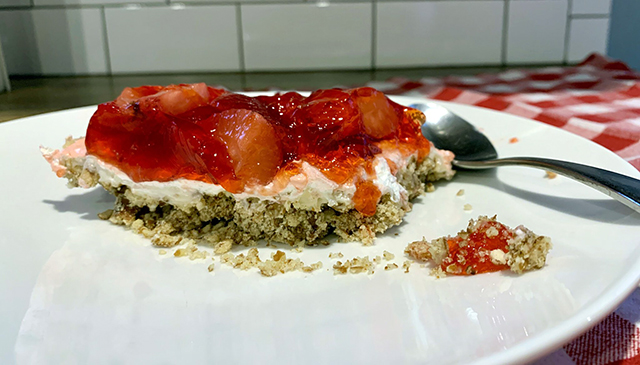
Yes, you read that right. Pretzel Salad. This dish breaks all the rules – it presents as a dessert but is in fact a side, served with the main course. It’s salad reimagined yet its vintage. It’s unconventional and irresistible. It’s what you need to make for your next dinner party, potluck, Easter, Passover, and for the summer BBQs in near sight. It has a story, a vibe, and a taste that will wobble heads.
The ingredients – pretzels, strawberry, cream cheese, whip cream, butter, and… jello.
My friend, Mike “The Soap Man” Benigno of Holland Avenue Soap, Co.,—tipped me off to Pretzel Salad back in December. I get a text, “Merry Christmas! Curious in the vein of Jello arts, are you aware of Pretzel Salad? It’s that Midwest thing—my mother-in-law and her whole family are into it big time.”
I listed, “What the heck is Pretzel Salad?” on my editorial calendar.
When The Soap Man first started dating his wife, Ellen, they would go to Mike’s parents’ house in Belle Harbor for dinner. Ellen wanted to bring an impressive dish and something from her Midwestern roots to share with “The New Yorkers.” It’s a tradition and staple in her family and the Pretzel Salad recipe came by way of her Mother, Pam Colwell.
Pam and her Husband Mike moved from Illinois to Arverne recently, to be closer to their grandchildren, and to inadvertently introduce Rockaway to the Pretzel Salad.
I scheduled an interview with Mike’s mother-in-law, to learn more about the strange salad. Pam said she has been making the recipe for over 40 years and brings it to all the family gatherings. It’s a favorite.” she said. “Thanksgiving turkey, roast beef, pretty much goes with anything.” I laughed. She politely said, “You can also eat it as a dessert if you like.,” though I gathered that is not the Midwestern way.
What does it taste like? Pam paused, “It’s kind of like a strawberry cheesecake with pretzels!”
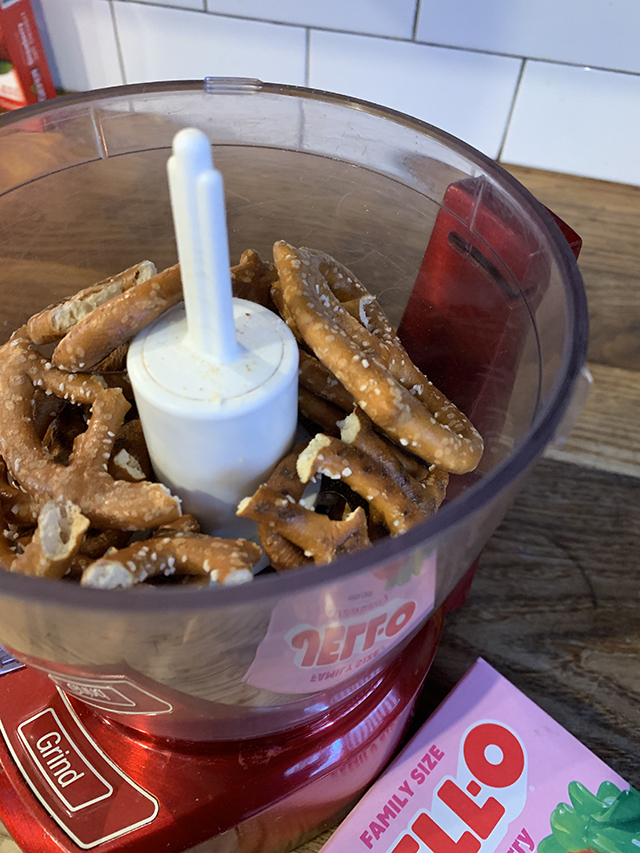
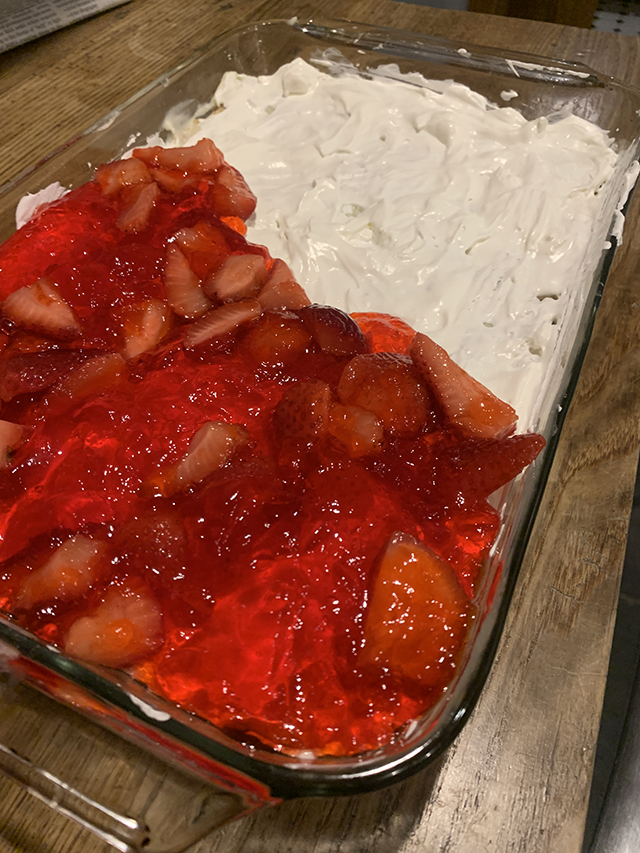
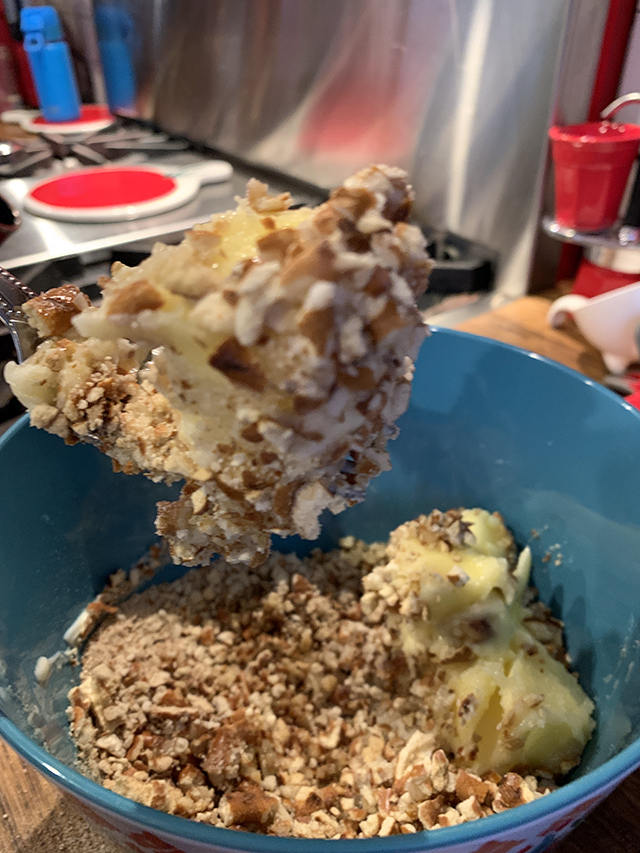
Pam’s Pretzel Salad:
Ingredients:
2, 2/3 cups crushed pretzels
1 cup butter, melted
3 tablespoons white sugar
1 (8 ounce) package cream cheese, softened
1 cup white sugar
8 ounce container of frozen whipped cream
6 ounce packages strawberry Jell-O
2 cups boiling water
10 ounce package of sugared, frozen strawberries
More butter for baking dish
Directions:
- Preheat the oven to 350°F.
- In a food processor, crush the pretzels to a chunky consistency. Add to a mixing bowl and mix in the melted butter and 3 tablespoons of sugar; spread mixture into the bottom of a 9×13 inch baking dish.
- Bake for 10 minutes, set aside to cool.
- In a large mixing bowl, cream together the cream cheese and sugar. Fold in the whipped cream.
- Spread the mixture onto the cooled crust.
- Quarter the frozen strawberries. Dissolve gelatin in boiling water. Let it cool for a few minutes, then stir in the frozen strawberries and allow the jello to set half way – about 45 min. Check occasionally.
- When the mixture is the consistency of egg whites, spoon over the cream cheese layer.
- Refrigerate until set. Best made the day before serving.
Taste this: a crunchy, salty, buttered pretzel crust layered under a sweet, cream cheesy spread fluffed with whipped cream and topped with bouncy, sweet strawberry-infused jello. It’s an unlikely, yet perfect combination of textures and sweet and savory flavor. Not to mention, it looks adorable.
According to Farmers’ Almanac, the strawberry pretzel salad was first introduced in “The Joys of Jell-O,” a cookbook published by General Foods in 1963. But some strongly believe its origins trace back to inventive German immigrants. It is said the recipe can be found in the “Brentwood Civic Club Cookbook” dated 1960, credited to second-generation German immigrant Gerry Fanz Sullivan. And Southerners, claim it too? Clearly a congealed masterpiece of this caliber would spark country-wide origin debate.
For more vintage recipes and jello art, visit theglorifiedtomato.com and follow Paula’s jello journey on IG: @theglorifiedtomato.
Source

























